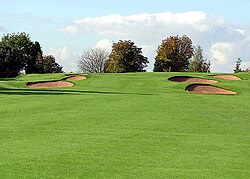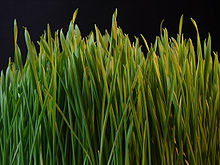Grass: Difference between revisions
| Line 86: | Line 86: | ||
[[fi:Ruoho]] |
[[fi:Ruoho]] |
||
[[uk:Трава]] |
[[uk:Трава]] |
||
==External links== |
|||
*[http://www.b-visible.co.uk/article/why_the_grass_is_green.html Why is the grass green?] |
|||
Revision as of 16:35, 23 May 2007
Editing of this article by new or unregistered users is currently disabled. See the protection policy and protection log for more details. If you cannot edit this article and you wish to make a change, you can submit an edit request, discuss changes on the talk page, request unprotection, log in, or create an account. |

Grass is a common word that generally describes a monocotyledonous green plant in the family Poaceae. True grasses include most plants grown as cereals, for pasture, and for lawns. They include some more specialised crops such as lemongrass, as well as many ornamental plants, and some weeds. They also include plants often not considered to be grasses, such as bamboos.

The term 'grass' is sometimes used to describe related plants in the rush (Juncaceae) and sedge (Cyperaceae) families, that resemble grass somewhat. It may also be used to describe other unrelated plants, sometimes of similar appearances to grass, with leaves rising vertically from the ground, and sometimes of dissimilar appearance.
Grasses and grass-like plants have proven to be among the most versatile of life forms, thriving on every continent except Antarctica. Plants having grasslike structures have existed for millions of years, providing fodder for Cretaceous dinosaurs, whose fossilized dung contains phytoliths of a variety of grasses that include the ancestors of rice and bamboo (Piperno & Sues, 2005). Grasses have adapted to conditions in lush rain forests, dry deserts, and cold mountain steppes, and are presently the most widespread of all plant types. Plants of this type have always been important to human beings. They provide the majority of food crops, and have numerous other uses, such as feeding animals, and for lawns. There are numerous minor uses, and grasses are familiar to most human cultures.

Other plants called grass
Plants that are commonly called grass, but are not true grasses include:
- Cannabis (more commonly known as marijuana)
- China grass, more commonly known as Ramie (Boehmeria nivea), a nettle grown for bast fibres, in the family Urticaceae
- Ditch grass or Wigeon grass (Ruppia maritima) in the family Ruppiaceae
- Fish grass (Cabomba caroliniana), a freshwater aquatic
- Goosegrass (Galium aparine)
- Mondo grass or Lily turf (Ophiopogon japonicus), an Asian ornamental ground cover
- Nut-grass or Nutgrass, a common lawn pest (Cyperus rotundus) in the family Cyperaceae
- Pepper grass (Lipidium spp.) in the family Brassicaceae
- Sawgrass, abundant in sub-tropical marshlands (Cladium spp.) in the family Cyperaceae
- Scurvy-grass (Cochlearia species) in the family Brassicaceae
- Scurvy-grass Sorrel (Oxalis enneaphylla) in the family Oxalidaceae
- Seagrasses, including Eel grass (Zostera spp.)
- "Sleeping grass" (Mimosa pudica), a legume (family Fabaceae) and lawn weed
- Xyridaceae, known as the yellow-eyed grass family.
Grass and society

Grasses and grass-like plants have long had significance in human society, having been cultivated as food for domesticated animals for up to 10,000 years. (See grass fed beef.) They have been used for paper-making since at least 2400 BCE.
The maintenence of a grass lawn is a sign of a homeowner's responsibility to the overall appearance of their neighborhood. Many municipalities and homeowner's associations have rules about this. Some require lawns to be maintained to certain specifications, sanctioning those who allow the grass to grow too long. In communities with drought problems, watering of lawns may be restricted to certain times of day or days of the week.
Grass is also used in several contexts in sports, most notably with sports played on fields such as football, cricket, baseball, and soccer. In football, grass may be replaced with astroturf, an artificial substitute. Two sports, golf and tennis, are particularly dependent on the quality of the grass on which the sport is played.

In tennis, grass is grown on very hard-packed soil, and bounces may vary depend on how healthy the grass is, how recently it has been mowed, and the wear and tear of recent play. The most famous grass tennis court in the world is Centre Court at Wimbledon. Tennis, however, is usually played on clay courts, and only a few regular tennis tournaments are played on a grass court. The surface is less firm than hard courts, causing the ball to bounce lower, and so players must reach the ball faster. Due to high maintenance costs however, grass courts are now rare as they must be watered and mowed often, and take a longer time to dry after rain than hard courts.

Golf, on the other hand, is always played on grass, and is dependant on the maintenance of a very large area of well-cut grass. Grass on golf courses is kept in three distinct conditions, that of the rough, the fairway, and the putting green. Grass on the fairway is kept very short and even, allowing the player to cleanly strike the ball, while playing from the rough is a disadvantage because the grass in the rough is generally much longer, which may affect the flight of the ball. Grass on the putting is the shortest and most even of all, ideally allowing the ball to slide smoothly over the surface. An entire industry revolves around the development and marketing of grasses for golf courses.
Idioms
Several idioms evoke images of grass. For example:
- "The grass is always greener on the other side [of the fence]" suggests that the greenness of grass is a positive quality, and reflects the general sentiment that people believe their neighbors to have fewer troubles than themselves..
- "Don't let the grass grow under your feet" references the speed with which grass grows.
- "A snake in the grass" literally cautions about the dangers that may be hidden in plants that cover the ground, and is generally used to describe treacherous people or things.
Grass Fiction
Grass plays a central role in two important science fiction catastrophe novels from the 1940s and 1950s, Ward Moore's Greener Than You Think, in which the world is slowly taken over by unstoppable Bermuda Grass, and John Christopher's The Death of Grass, in which a plague that kills off all forms of grass threatens the survival of the human race.
See also

References
- Chapman, G.P. and W.E. Peat. 1992. An Introduction to the Grasses. CAB Internat., Oxon, UK.
- Cheplick, G.P. 1998. Population Biology of Grasses. Cambridge University Press, Cambridge.
- Milne, L. and M. Milne. 1967. Living Plants of the World. Chaticleer Press, N.Y.
- Soderstrom, T.R., K.W. Hilu, C.S. Campbell, and M.E. Barkworth, eds. 1987. Grass Systematics and Evolution. Smithsonian Institution Press, Washington, D.C.
- Went, Frits W. 1963. The Plants. Time-Life Books, N.Y.
